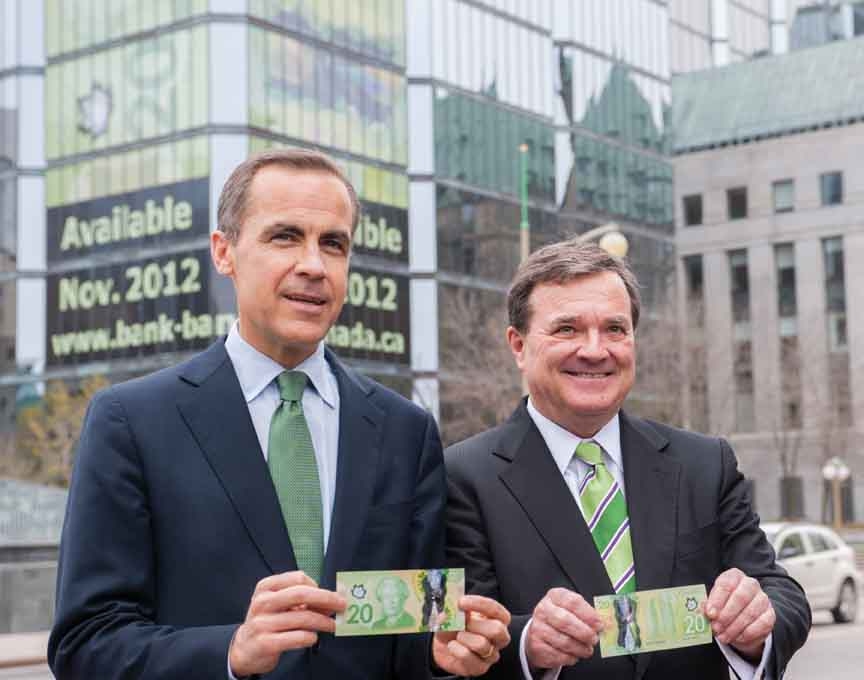
Business Profile: Winning at the Carney-val
By: Dan Donovan and Harvey Chartrand
Bank of Canada Governor Mark Carney was called a “hot commodity” by Postmedia News in April. Carney, 47, has been credited with shielding Canada from the worst effects of the 2008 global financial meltdown, when the United States’ and Europe’s financial systems nearly collapsed. At the time, Carney was the untested wunderkind at the Bank of Canada who had replaced the highly respected David Dodge, a revered giant with professionals in the Canadian banking and investment world. By 2009, Carney’s response to the financial meltdown had earned him recognition by the Financial Times and TIME magazine as a superstar in the world of high finance.
By 2012, Carney had enough respect from international governments that he was selected to chair the powerful Financial Stability Board, an institution of the G-20 major economies based in Basel, Switzerland charged with co-coordinating the overhaul of international banking regulations. (While there has been no indication of Carney’s priorities as chairman, on the day of his appointment, the Board published a list of 29 banks that were considered large enough to pose a risk to the global economy in the event that they failed). In April 2012, a rumour circulated that the British Cabinet was interested in naming Carney as its Governor. Carney put an end to that rumour by stating that he was staying at the Bank of Canada, reassuring Canadian banks it was business as usual.
Mark Carney worked his way up the ranks of Goldman Sachs, the Department of Finance Canada, and the Bank of Canada, as deputy governor. Armed with his great pedigree and understanding of the complex international finance system, combined with his experience at Finance under David Dodge, Carney was able to devise a strategy to allow Canada to navigate through the worst tremors of the crisis. Most importantly, he set in motion a plan to protect Canada from the delayed financial aftershock that is now undermining many First World nations and threatening the once overheated economy of China, which Canada is increasingly reliant upon as an export market.

Part of this strategy was recently uncovered. In a study released on April 30 by the Canadian Centre for Policy Alternatives (CCPA) titled The Big Banks’ Big Secret: Estimating Government Support for Canadian Banks during the Financial Crisis, the previously secret extent of the extraordinary support required by Canada’s banks during the 2008-2010 financial crisis was revealed. For much of the past three years, Canadian banks were touted by Federal Finance Minister Jim Flaherty, the federal government—and the banks themselves—as being much more stable than other countries’ big banks. Canadians were assured that our banks needed no bailout and, because of their management and lending practices, were the most secure banks in the world. The CCPA’s latest study suggests that this was not the case.
According to the study by CCPA senior economist David Macdonald, support for Canadian banks reached $114 billion at its peak.
“At some point during the crisis, three of Canada’s banks—CIBC, BMO and Scotiabank—were completely underwater, with government support exceeding the market value of the company,” says Macdonald. “Without government supports to fall back on, Canadian banks would have been in serious trouble.”
Between October 2008 and July 2010, Canada’s largest banks relied heavily on financial aid programs provided by the Bank of Canada, the Canada Mortgage and Housing Corporation (CMHC) and the U.S. Federal Reserve—all at the same time. The study estimates the value of government support by combing through data provided by CMHC, the Office of the Superintendent of Financial Institutions and the Bank of Canada, as well as quarterly reports of the banks themselves. Carney might call it “liquidity support” but Macdonald says it was a bailout. “Whatever you call it, Canadian government aid to the tune of $114 billion for the country’s biggest banks was far more indispensable than the official line would suggest.”
Because of this necessary but secret infusion of multi-billion-dollar loans, no Canadian banks failed – as opposed to 400 U.S. banks that did – the loans to Canadian banks were quickly repaid. The Government of Canada even made a $2.5-billion profit on the bank loans, according to CBC Ottawa. Ironically, over the entire aid period, Canada’s banks reported $27 billion in total profits between them, and the CEOs of each of the big banks were among the highest-paid Canadian CEOs. Between 2008 and 2009, each bank CEO received an average raise in total compensation of 19 per cent. There is a serious ethical question related to why the CEOs of the CIBC, BMO and Scotiabank paid themselves so handsomely when their banks were so stretched. That is quite a contrast to Carney, who left behind millions of dollars in salary when he quit Goldman Sachs to take up public service. He believes policy can make a difference. And he has made a difference. The reality is that the strategy Carney put in place for those types of loans to be accessed by Canadian banks worked and everyone, including taxpayers, came out on the winning side. Internationally, Carney was seen as the smart go-to guy on how to fix the international banking system.

Prior to being selected to chair the Financial Stability Board, Carney showed some good old Canadian grit. It became clear that he could not only take a punch but deliver one as well. At a September 2011 meeting of some of the world’s most influential bankers, Jamie Dimon, head of JPMorgan Chase & Co, directed a tirade at Carney during a private gathering of the world’s most influential bankers in Washington, D.C. Carney was the lead in presenting the efforts by the Group of 20 major economies to overhaul an international regulatory regime that was exposed as weak by the financial crisis. Carney was pushing for an international policy makeover to reshape global financial regulation. Dimon opposed this.
The confrontation occurred when Dimon attacked a plan backed by Carney that would require a few dozen lenders (including JP Morgan) to hold reserves at levels 2.5 percentage points higher than other banks – a measure inspired by the economic destruction caused by the collapse of Lehman Brothers Holdings Inc. After listening to a tirade from Dimon, including the suggestion that his proposals were anti-American, Carney pushed back with a cogent and firm defence of the G-20’s efforts to construct a regulatory regime that will significantly reduce the risk of another global financial crisis. It was a dressing down of significant proportions.
Three weeks later, when the Occupy Wall Street (OWS) demonstrations and other expressions of frustration with the global economic and financial system highlighted the need for policymakers to show they are serious about forcing change, Carney commented that the movement was an understandable result of the “increase in inequality” – particularly in the United States – that started with globalization. “You’ve had a big increase in the ratio of CEO earnings to workers on the shop floor and then on top of that, a financial crisis. There’s a frustration with policy and a frustration that, ‘are things going back to business as usual?’ If I may say, that is not going to happen, but I can understand the frustrations.’’
Carney then added that it was his view that the OWS protests are a “democratic expression of views”’ and “entirely constructive.” A few months later, Carney was named Chairman of the Financial Stability Board. Clearly, he was not one to be cajoled or pushed around.
Canada has by no means emerged unscathed from the global financial turmoil. Carney’s biggest worry is the explosive growth in household debt.
His concern follows the release on April 18 of the Bank of Canada’s latest monetary policy report – a quarterly economic overview compiled by the central bank. The report highlights the exponential growth of home equity lines of credit (HELOCs) and mortgage refinancing in the past decade, which have surged to $64 billion as of 2010 from $8 billion in 2001. Since the Bank of Canada sets the interest rate that determines the monthly mortgage rate paid by Canadian families, a comment on interest rates from Carney can give banks the jitters and surely affects the blood pressure of millions of mortgage-paying Canadians each month. Carney continues to steadfastly pursue policies which discourage increasing personal or household debt. He insists that mortgages must have strict conditions attached to avoid a U.S.-style mortgage crisis.
The report once again pegged the massive debt loads of Canadians as one of the biggest domestic risks to Canada’s economy. While the bank sees an eventual reversal in the growth of household debt, Carney said that household debt-to-GDP ratios are expected to grow even higher for the foreseeable future, and gave no forecast for when Canadians might start paring down their debt. “It’s hard to predict exactly when the process will come to an end,” he said. The good news is that under Carney’s steady helmsmanship, the central bank now sees Canada’s economy growing by 2.4 per cent in 2012 over its earlier 2.2 per cent target.
Carney lives in Ottawa with his wife Diana, an economist specializing in developing nations, and his four daughters.












